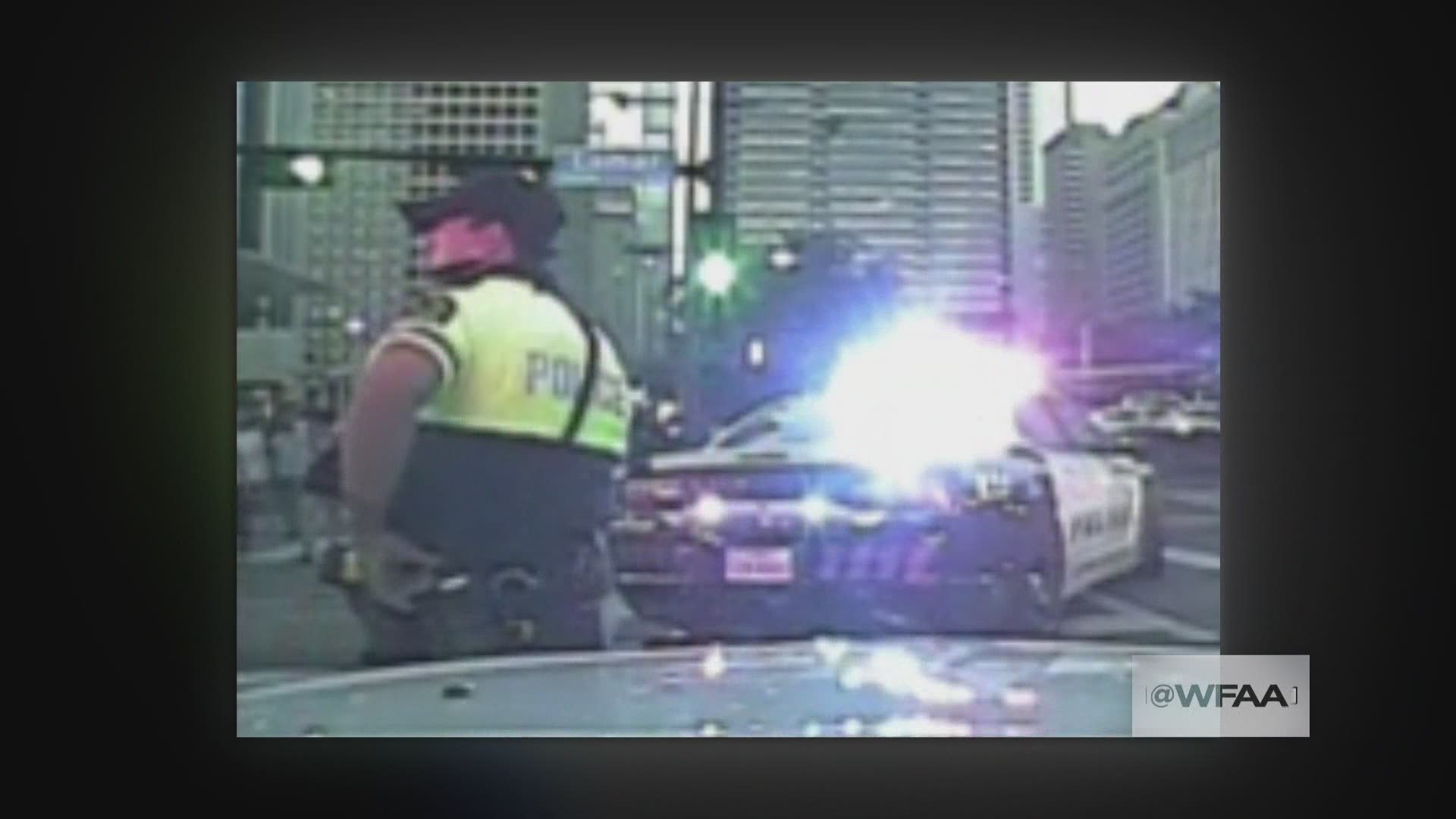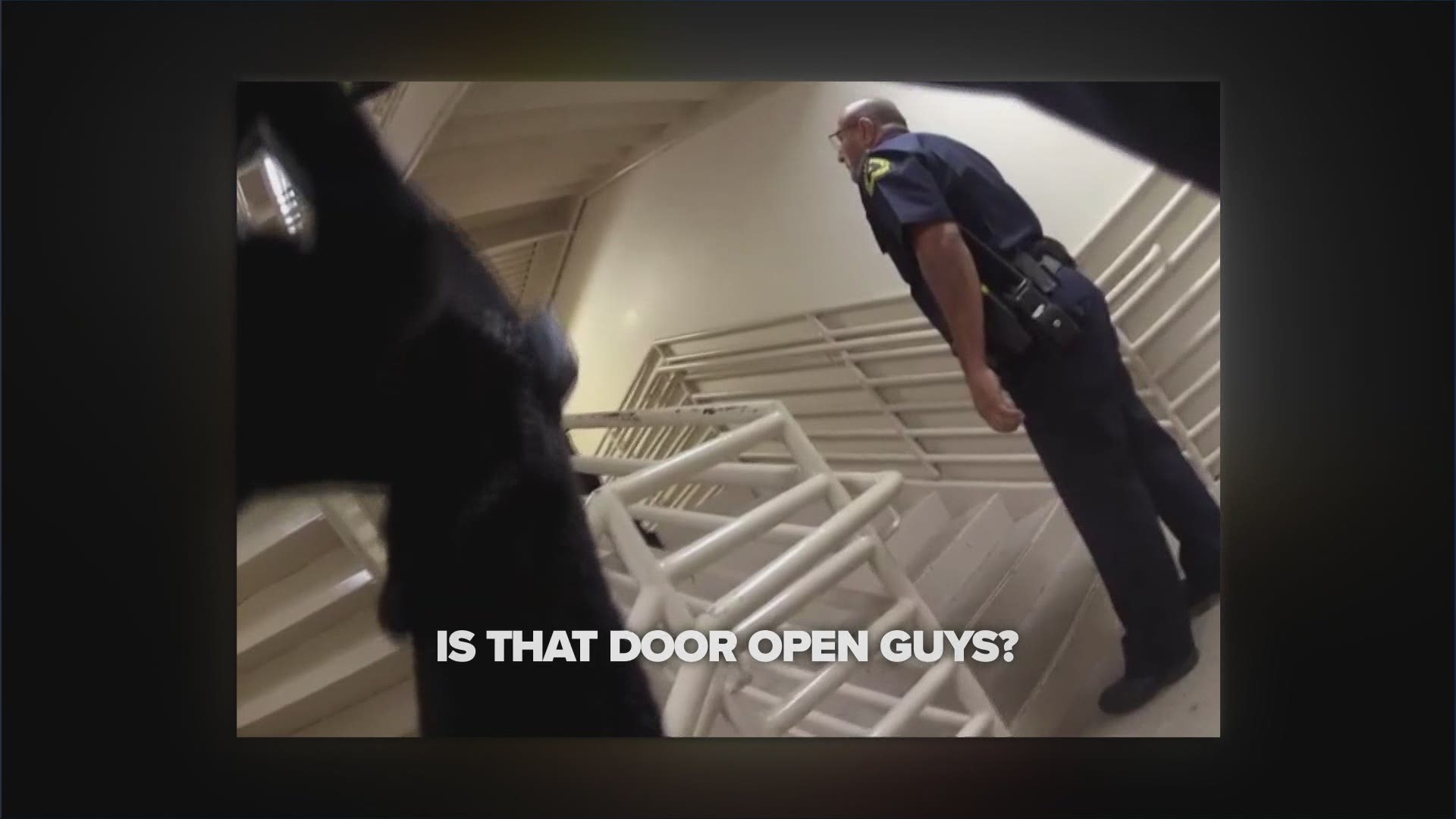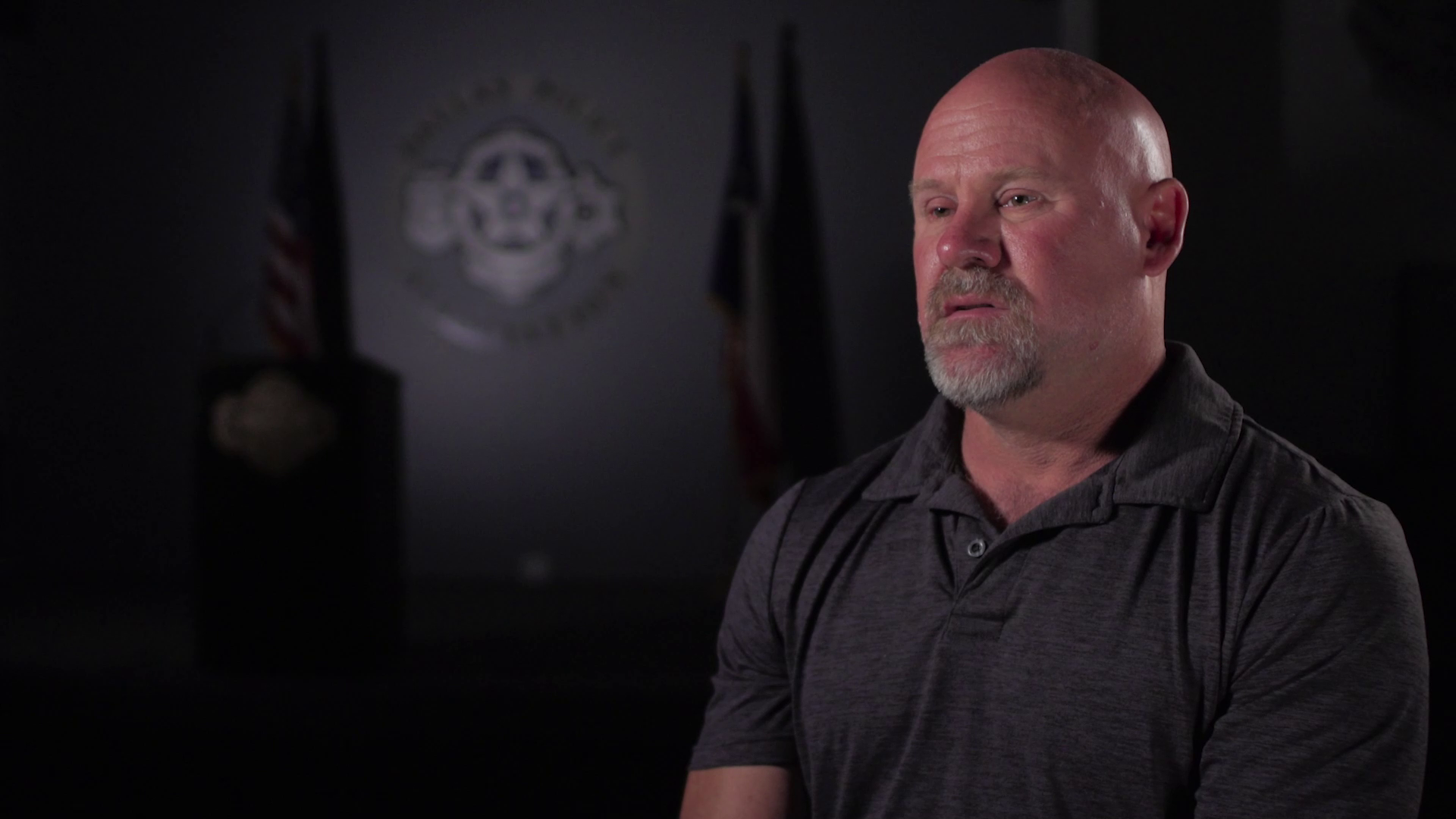DALLAS — Editor’s Note: Five years ago, four Dallas police officers and a DART police officer were killed during an ambush attack at the end of a peaceful protest. In October 2018, WFAA filed an open records request seeking the entire police investigation. Police and city officials repeatedly sought to withhold the records. The Texas Attorney General sided in favor of WFAA. However, only a trickle of records were released for more than a year after the ruling. WFAA filed a complaint with the Attorney General’s Office asking that the AG force the department to comply with its ruling. Over the last six months, the department has released thousands of photos and dozens of hours of body cam and dash cam video. What follows is an account of that night based on interviews with officers present, as well as the dash and body cam video released to WFAA. None of it has ever been seen before publicly.
(Scroll down for the full video at the end of the first section.)
----
It was July 7, 2016.
Thousands were gathered in downtown Dallas, protesting the police shootings of Philando Castile in Minnesota and Alton Sterling in Louisiana.
“There was no indication of anything going any different than any other protests that I've been involved in in my 31-year career,” said Major Paul Junger, one of the commanders overseeing the protest.
As the protest wound through downtown streets, police provided traffic control. They were there to ensure protestors could safely exercise their First Amendment rights.
“Everybody that that passed us, that walked through us was friendly, said hello,” said Major Rick Rivas, another commander overseeing the protest.
It was almost 9 p.m.
“We were so close to this peaceful rally ending,” Rivas said.
Dash cam and body cam video show Officers Pat Zamarripa, Michael Krol and Senior Cpl. Lorne Ahrens posted at the corner of Lamar and Main Streets. In the next few minutes, the three will be the first casualties of a deadly ambush.
Through Krol’s body cam, protestors can be seen passing by the intersection. Several times, he looks down the street at an SUV parked near El Centro College on Lamar Street, hazard lights flashing.
“You see cars parked all the time with their hazards on," Junger said. "You don't think twice about it."
The SUV belonged to Micah Johnson, a 25-year-old Army veteran, bent on killing police in retaliation for what he believed were the unjust killings of Black men by police.
“He had a plan,” Junger said. “He had a will to die. He didn't advertise it before he started shooting. He just started shooting. So, he had the element of surprise.”
Shots ring out
When shooting began, protestors ran for safety. Officers ran toward the shots, taking cover and protecting bystanders.
“We didn’t really know if we had multiple snipers, or where they were located,” said Assistant Chief Reuben Ramirez, who was a lieutenant in 2016. He was at southeast patrol when the shooting started and raced downtown, as did hundreds of other officers from across the city.
Seconds before the shooting started, dash cam video shows Zamarripa sitting in his squad car listening to a Texas Rangers baseball game. He immediately ran toward the gun fire.
“Zamarripa is running with me,” said Senior Cpl. Ivan Saldana. “So when he got hit, he just fell. …I can see the rounds hitting the pavement and I'm already behind the squad car, behind the engine and I got my gun out and I felt the bullet just hit between my legs and the shrapnel hit me.”
From above, guests at the Crowne Plaza Hotel captured cell phone video of the shooter. On the video, the gunman can be seen taking cover behind the pillars outside El Centro College and firing at police officers.
“He’s shooting at the cops, dude,” the man who’s recording the video said. “That guy right there with an assault rifle.”
Sgt. Ivan Gunter headed the team that included Krol, Zamarripa and Ahrens and Saldana.
“I barely was able to crawl to a radio and let them know we're in a kill zone,” he said.
On Gunter’s dash cam video, he can be heard begging for help and telling people to stay back.
“I’ve got rifle fire, automatic rifle fire in my area,” he says in the video. “He’s circling back around.”


A WFAA photojournalist captured Gunter and other officers rushing to Zamarripa after he was shot. The officers loaded him into the back of a squad car.
Dash cam video shows the frantic ride to the hospital.
“Come on, please, don't die on us,” says the officer driving the squad car. “Stay awake, man. Squeeze my hand.”
Rushing to help
Junger was a block away when the shooting began. He rushed toward the gunfire.
“I saw Micah disappear behind a column,” Junger said. “I remember thinking if I see him again, kill him …. This calm came over me and I remember thinking ‘front sight, and squeeze.’ I shot at him a couple of times, and then ran into the intersection to provide first aid.”
Junger saw two wounded officers on the ground, and other officers trying to help them. Only later would he learn that it was Krol and Ahrens.
“I told them, ‘Nobody’s coming,’” he said in an interview. “’There’s no ambulance that’s coming in here until this scene is secure. Unload these cars and we’ll put the wounded in the cars and self-transport to Baylor Hospital.’”
As police converged on him, Johnson turned his focus on El Centro. He had parked in front of the college’s entrance on Lamar Street. Body cam video from an El Centro police officer inside the entrance shows Johnson repeatedly shooting through the glass doors in an apparent effort to get inside.
“Where is he?” an El Centro officer says in the video. “Where? Where? Where?”
Officers scrambled to avoid the gunfire.
“Get down,” an officer says. “Get down. Get back.”
In the video, he orders other officers to get rifles, and says he thinks the shots are coming from an SUV parked outside.


DART police officer Brent Thompson was right outside.
A bystander’s cell phone video shows him taking cover behind a pillar, firing at the gunman. The shooter comes around the pillar, and shoots Thompson from behind.
Moments later, the El Centro officer’s body cam video shows him going outside and finding Thompson.
“We have an officer down at Elm and Lamar!” he tells dispatchers. “Officer down, officer down! Get me EMS now!”
Thompson would not survive.
Several officers have said that Thompson’s actions helped save lives because he distracted the gunman from shooting at officers in the intersection at Lamar and Main.
“I will say that Brent Thompson is a hero to this day,” Rivas said.
Search for the shooter
As the attack continued, an officer saw Johnson run around the north side of El Centro, onto Elm St. He shared a description of the shooter.
“He was wearing a green vest,” according to audio captured on body cam video. “He had on a tactical vest. Tan pants.”
Officers saw blood drops and an empty magazine on the ground near the El Centro entrance on Elm, which Johnson also shot through, police said. Rivas and other officers began hunting for Johnson inside the college.
It’s just after 9 p.m. At this point, Zamarripa, Krol, Ahrens and Thompson have been fatally shot, and several others wounded in the battle on the street.
Johnson was also injured, and left police a blood trail to follow. They followed it to a stairwell. Inside, they saw blood on a railing. Blood was smeared on the walls on a second-floor landing. Police believe Johnson waited there for officers.
Body cam video shows Rivas walking up the stairs, his pistol drawn.
“I didn't know whether this was going to be my last minute on this earth because I knew that he was heavily armed,” he said in an interview. “He could have popped up from any cranny, nook, corner and jumped out and started firing at us.”
Rivas silently prayed the Lord’s Prayer as he climbed the stairs.
“I said, ‘If I don't make it out of here, I just wanted to clear my head and my heart with the Lord and just make right with him. Let him know that I was ready,’” Rivas said.
A fifth officer down
As officers hunted for him, Johnson ran to a second-floor window. He saw Sgt. Michael Smith in front of a 7-Eleven on Elm Street. Johnson fired out the window, killing the sergeant.
“Michael never saw it coming,” Rivas said.
Body cam video shows the moment that patrol officers and the tactical team found Johnson.
“Black supremacy! Black liberation!” Johnson shouted, opening up with a barrage of gunfire on officers.
Officers returned fire.
“Come out with your hands up! Drop your weapon and come out!” an officer yelled.
“No surrender!” the gunman shouted, opening fire again.
The gunman was around the corner down a hallway. Officers posted up, taking cover to avoid the ongoing rifle fire.
“What’s your name?” another officer asked.
“X,” Johnson said.
An officer can be heard telling him to put the gun down and come out.
“Why would I do that?” Johnson responded.
“Well, I know you’re prepared for this,” a member of the tactical team told him. “Obviously, this isn’t going to end well.”
In response, the gunman opened fire again, sending sheetrock and shrapnel flying.
Senior Cpl. Matt Banes returned fire. He and others quickly realized the precarious position they were in. Rifle rounds were passing through the sheetrock with ease, and there was little solid cover.
“We were in a bad spot,” said Banes, then a member of the tactical team. “We could tell he had some sort of training, so we had to give that due respect. This wasn't somebody that was going to fall for our usual tactics.”
Negotiating with a killer
Banes talked to the gunman until the tactical team’s hostage negotiator, Larry Gordon, arrived.
“Hey X, can you talk to me for a minute?” Gordon asked the shooter in one of the videos. “What’s going on today, man?’
Gordon, now a sergeant, said his goal was to slow things down and connect with the gunman.
“He’s very emotional,” Gordon said in an interview. “He wanted all of us to ‘transition’ tonight and I said, ‘What do you mean by transition?’ He says, 'Transition from this life to the next.’”
Gordon talked to the gunman for four hours.
“You say you're going to die today anyway so what does it matter anyway, bro?” Gordon asked.
“Stop calling me bro,” the gunman snapped back.
“I won’t call you, bro,” Gordon responded. “You say we’re killing your Black brothers. Did you know I’m Black?”
The gunman’s response is inaudible, but he would soon tell Gordon that he should turn his weapon on the officers behind him.
“I was blown away by that,” Gordon told WFAA. “We all looked at each other like, ‘Who is this guy?’”
Johnson told Gordon that he served in the military and that he had been deployed. He steadfastly refused to tell him his name.
“Micah wasn’t delusional,” Gordon said. “He was very lucid, very sane and very in control.”
A plan to end the standoff
As the hours wore on, it became clear that the gunman wasn’t going to give up. He told police he’d planted bombs. He taunted officers to come down the narrow hallway.
Members of the tactical team worked through the options.
Banes said they talked about using a 50-caliber weapon to fire at the shooter similar to what had been done 14 months earlier to a suspect who drove an armored truck into police headquarters. Officers quickly ruled that option out. It was just too dangerous to do inside the college.
There was talk about rappelling down the building or coming through the ceiling. Those are ruled as being too dangerous for the officers who would carry it out. Waiting him out also was not an option because he could have charged officers in the narrow hallway.
Eventually, Senior Cpl. Jeremy Borchardt and others came up with a plan to use robot strapped with explosives to end the standoff.
David Brown, who was Dallas police chief at the time, approved the tactic. It was the first time that explosives strapped to a police robot had ever been used in American policing.
It was Borchardt’s task to carry out the plan.
Police put about a pound of C-4 on the robot, using a book they borrowed from El Centro’s library to stabilize it.
Borchardt then used a remote to drive the robot down the hall. He could see on the robot’s camera that the gunman crouched to the ground with the rifle up. Johnson had been told that the robot had a phone on it.
“As I got even closer, he goes down, and almost lays down in front of the thing,” Borchardt said in an interview. “What I think was happening is that he was anticipating an assault coming behind the robot.”
Borchardt pushed the detonator when the robot got close enough.
“Nothing happened. Just quiet,” he said.
He pushed it again. Still nothing. Just as he pushed it a third time, a tactical team member pushed the backup detonator, triggering an explosion.
“We heard the big boom,” Borchardt said.
In the aftermath, pictures showed the body of Micah Johnson amid the rubble. His rifle, two handguns and more ammunition lay close by. Officers found a bag filled with supplies.
“I had to see who this person was that I've been talking to for four hours, that had me so afraid,” Gordon said. “Once I looked at him, I was thinking, ‘This is just a guy. This is not a monster. This is just a guy.’”
Honoring the fallen
In the days following July 7, the world stopped to honor the officers who died: Officer Pat Zamarripa, Officer Michael Krol, Senior Cpl. Lorne Ahrens, Sgt. Michael Smith and Officer Brent Thompson.
Five years later, the detail room at Southwest Patrol, where Zamarripa, Krol and Ahrens were assigned, has become a memorial to them.
“The rest of the world has moved on,” Junger said. “But our department will never heal from it. It's something that you live through. You can't forget.”



